(Re)Making a Better World: A Conversation with Charles Campbell
As a founding member of Skewed Visions, Charles Campbell has been bringing innovative theater to the Twin Cities for 16 years. In this far-ranging conversation, writer Jay Orff and Campbell hit on creativity, collaboration, and the limits of language.
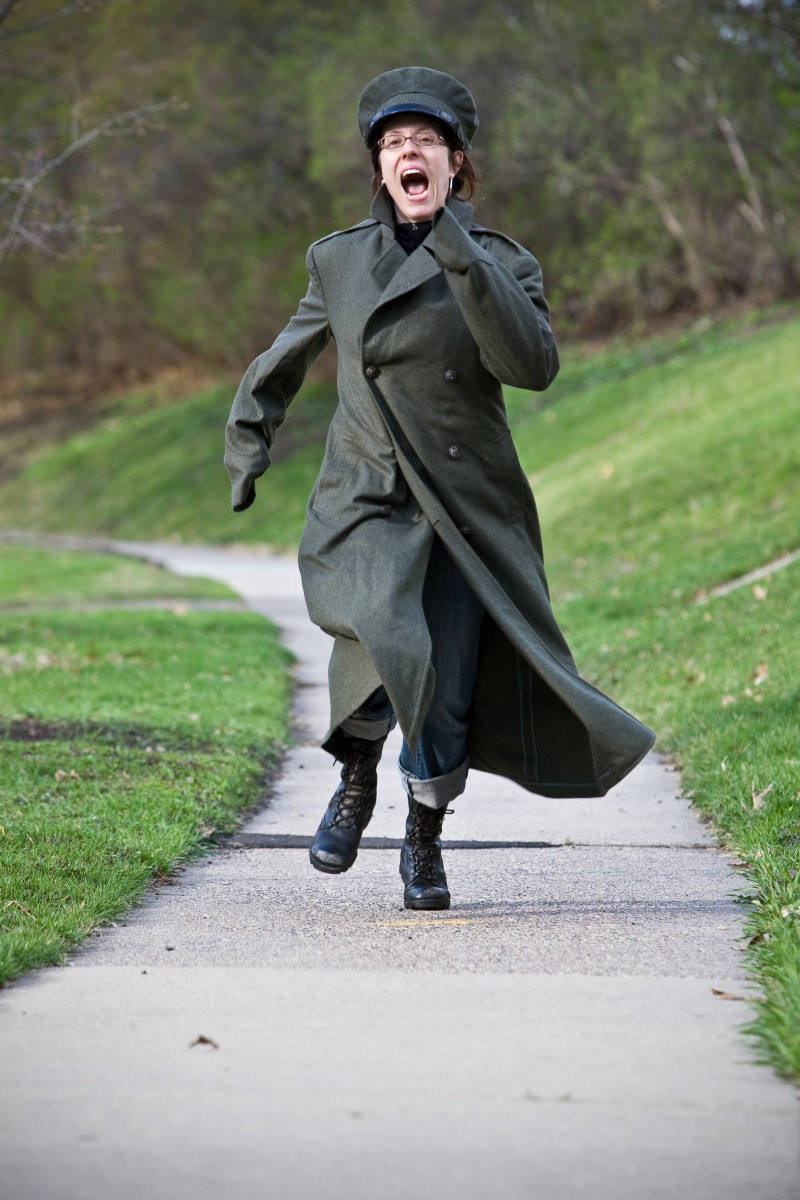

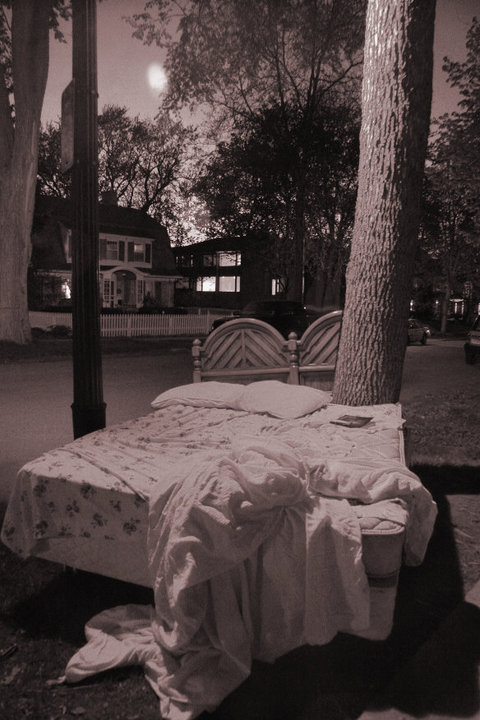
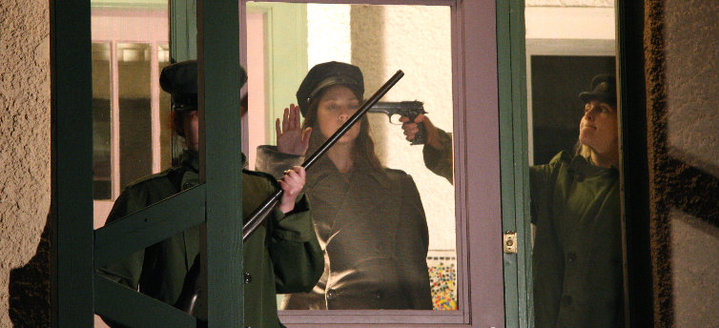
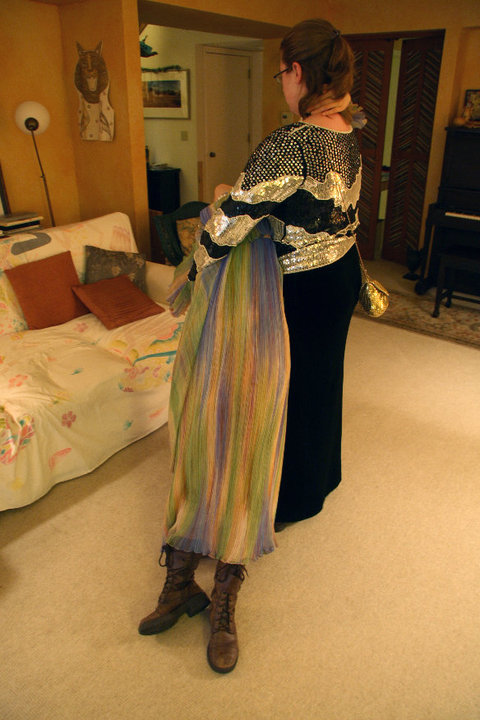
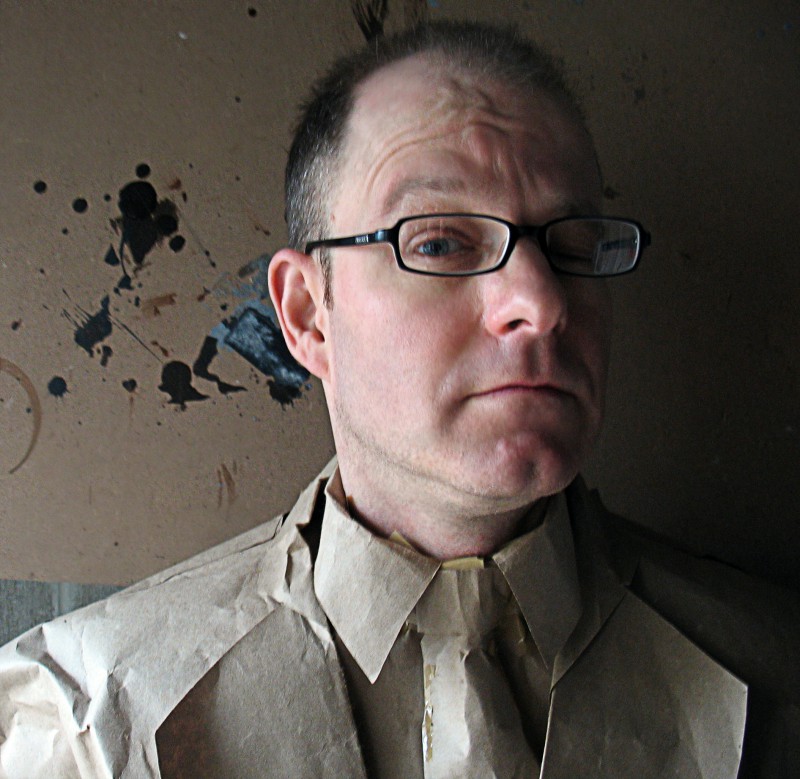
ON A SPRING EVENING IN 2009, I was walking the streets of the Mac-Groveland neighborhood of St. Paul as an audience member following the course of Skewed Visions’s production, He Woke Up in a Strange Place Called Home and Although Looking for Bed He Kept Finding Death Instead, created by Charles Campbell. Rather than being staged in a theater, the show opened in a pleasant living room of a private house — perhaps it belonged to one of the actors, who were seated in the room with us. Upon entering, we took off our shoes and my confusion began: Was I a guest or an audience member? The performance moved through the house to the deck, to the yard, and eventually spilled out onto the streets; the concrete felt cool on my bare feet. We walked one block, then another until we encountered a bed on the sidewalk where a scene occurred; and then we walked again, soon finding ourselves on the deck of another home where the action of the play continued. Across the alley, I noticed a garage door opening; deep into the play, I thought this, too, must be part of the performance, part of the action, and that something was happening in this garage a block away, which would inform or interact somehow with the performance. And it did. Of course, the woman wandering around her garage had no idea she had become a part of the production.
jay orffCollaboration is central to your work, and not just with performers and those expressly working on the production. For Skewed Visions, that engagement also seems to include, for example, interacting with the home in which a play is staged, or with a transportation system, or with the texts incorporated into a play. How far does your sense of collaboration go and why is this important?
charles campbell“Collaboration” is a scary word. Sometimes it means everybody talks at the same time, and no one is happy, and each person thinks, everyone else should just shut up and listen to me. At best, collaboration is a kind of open and receptive practice that accommodates the world outside without merely replicating it. It is a conversation, a dialog, an interaction in which everybody involved listens and talks coherently, but not only with people. Maybe that’s why I like collaborating with objects and spaces: They’re such good listeners, and so eloquent. And it’s been a useful term for my way of working, because my work always involves an encounter with something different — different people, different places, different things, different ideas – and then creating an experience in which this encounter can be manifested as an experience in time and space.
At the same time, “collaboration” has such relentlessly positive connotations: [the way most people use the term] doesn’t convey the misery that collaboration so often entails. It –- along with “compromise” and “love” –- is a word that often elides its complications, instead suggesting a bunch of Disney caricatures whistling their way into what, in real life, would be a miserable dank, dirty and dangerous pit, a situation that would have most of us clamoring for immediate reform if we didn’t benefit so clearly from the labor.
All vehicular traffic proceeding in the same direction on any road shall keep to the same side of the road, which shall be uniform in each country for all roads. Domestic regulations concerning one-way traffic shall not be affected.
Geneva Convention on Road Traffic, 1949
Usually, theaters work very hard (and use a lot of black paint) to hide the edges of their theater, the building in which performances occur. Ideally, we pay no attention to the “black box” housing us and so are better able to pretend we are actually in Willy Loman’s kitchen. This suspension of disbelief is precisely what allows the fiction of theater to occur; we temporarily accept the world of the play as a representation of something real. But Charles Campbell’s work with Skewed Visions, rather than asking us to ignore the theatrical environment, invites us to notice every inch of the space around us.
joWould it be possible for a Skewed Visions piece to take place anywhere else other than the particular location where it had been created and staged? For instance, what would happen to The Car (a performance which takes place in a real moving car on actual city streets) if you were driving around rural North Dakota rather than on Twin Cities streets, for instance?
ccWe’ve thought a lot about whether we can tour our site-specific work. The answer is both yes and no — of course. The more stable the experience I am trying to facilitate is, the less sense it makes to move that piece from one site to another. However, Skewed Visions recently took parts of The Car to Bowling Green, Ohio, and we discovered in very practical terms what happens [when we shift the location]. Bowling Green is a very different kind of community than the Twin Cities, and we were not able, in the time we had, to adjust the piece the way we would need to in order to take best advantage of those differences. On the other hand, the experience was still a very positive one for us and for our necessarily rather small audiences.
The truth is that space is not empty, and it is not neutral. A given space always has its own structures and movements and history. It is always alien: We never belong. In making work, I am, in part, intending to draw attention to the space by interacting with it, by making new ways in which the site can be experienced – the ways it is seen, noticed. And my making is not empty or neutral either. I come with my own prejudices and capabilities, my own history. In other words, the contact between my work and the spaces in which it takes place is an encounter between the Self and the Other. The encounter that is my and Gulgun’s and Sean’s work is a tension between these irreconcilable realities of difference. And these encounters change both the space and us, and our work. They’re a true conversation in that there are always misunderstandings, conflicts, tensions, points of intersection and agreement; and in that conversation — between us, the space and the work we make there — much of what is “said” is left unheard, because we were chewing at the time and really needed to pee. Taking a performance elsewhere always means, for Skewed Visions, the confrontation with a new relationship, a new encounter with a different Other that will leave both of us changed.
Cut and remove all tall grass and weeds over 8″ in height. Includes all boulevards, side yards, and along the alley.
Minneapolis Ordinances 227.90 and 227.100
Our choices are informed and circumscribed by what we have come to believe is right and wrong, beliefs gleaned as children from our community and its language and vocabulary of ideas and then internalized and taken for granted; we rely on these ingrained habits of thinking, regardless of how our sense of right and wrong may occur to others outside of our community. We are all trapped by those unchallenged assumptions and beliefs; change is difficult, even dangerous sometimes — but we always hold the key to our liberation. Simply put: In the act of imagining the world differently, it is.
joYou say you’re “pretty sure” what you do is theater. Where does the doubt come from?
ccI guess it depends on who you ask. I’ve been told I don’t do theater. I tell myself, at different times, I’m doing different things: dance, installation, object-theater, Interstitial Cross Media Platform Dingleberry Time Enhancement… What the hell is theater? I don’t know. Who cares, really?
But doubt comes from everywhere. I’m so insecure it’s a wonder my limbs don’t fall off; I’d put Descartes to shame. But there is also a positive side to doubt, and I don’t just mean skepticism. The uncertainty about whether something is working, whether an idea is good, whether what you want is possible to achieve — it’s sort of like an open door at the edge of a cliff. Without doubt the door is closed and – sure, you’ll never fall off a cliff, but – my god — you’ll never fall off a cliff. You’ll miss out on a sense of risk, a sense of danger, a sense of movement.
But my goal is not to redefine terms. My goal is to manifest the engagement of my thinking in the world. I imagine just like everyone else: Why do we go to work, fall in love, take out the garbage, work for justice, enjoy our friends, relish our enemies, write, read, talk? We are taking part in the world, inserting our little phrase in the greater conversation, thinking our paths across the wider human landscape.
When you come to a Skewed Visions performance, you are taking responsibility for your own experience. We will not tell you what you should hear. We will not show you what you are doing wrong. We are enacting our encounter with the world, and you must decide for yourself what you will get out of it.
The Commission identified several words that referred to excretory or sexual activities or organs, stated that the repetitive, deliberate use of those words in an afternoon broadcast when children are in the audience was patently offensive, and held that the broadcast was indecent.
Federal Communications Commission v. Pacifica Foundation, 438 U.S. 726, 1978
We don’t really think about it most of the time, but there is risk in walking. With each step we risk falling to the ground and hurting ourselves. Watch a child take their first tentative steps: they’re slowly learning how to manage those risks. And eventually, as we age, the uncertainty reasserts itself more clearly, and we’re as aware as toddlers of the risks of walking. But the danger is always there, just beyond our recognition in all of the countless steps we take between infancy and old age. It’s just that walking becomes an automatic behavior; we don’t generally stop to make a conscious choice from step to step. Is this step worth it? No, we just keep moving.
joYou mentioned to me earlier that traditional stagecraft usually works to create a unified vision, but that you aim to create a multi-vocal, multifaceted production. How do you think this difference in approach impacts an audience member’s experience of a Skewed Visions show?
ccWho the hell cares about the audience? Okay, that’s clearly meant to be provocative. But there is a truth here that goes beyond a stereotype of self-absorbed artist and the unknowable nature of every audience. To responsibly, ethically, and meaningfully encounter an audience – or even just another person in the street – you have to in some way step back, burrow in backwards, get yourself out of the way: listen intently. You have to care.
But I think that model of stagecraft is based on an understanding of theater as a text: that a play is to be visually understood by the audience, as if reading a book. They watch and decode the images and words they see and hear, often translating metaphors and symbols into personally relevant objects of knowledge. Conventionally, the playwright has a vision that is combined with the vision of a director, several designers, actors, musicians, et al., and the goal is often to streamline and clarify this vision into coherency. But at least since Einstein, when relativity reared its disruptive head, it has become possible to imagine other ways of seeing the world, of experiencing art. The audience can be the observer, but they can also be the experimenter, the object, the experiment, etc. When you begin to think about the experience of performance in this way, so many more things become possible for both the artists and the audience. It is very exciting. And it is very hard to go back to seeing theater as just a good way to tell a good story.
Also, I find stories inherently suspect in that I find troubling what so many people admire about them: their ability to organize experience in a coherent and satisfying way. This ability to organize and cohere that which is chaotic and overwhelming is, by definition, subject to the whims and caprices of Power: the Authority of the Teller. So to talk about the audience, in one sense, is to make a distinction that really is mostly relevant only to a prior way of thinking about the performative act. When you come to a Skewed Visions performance, you are taking responsibility for your own experience. We will not tell you what you should hear. We will not show you what you are doing wrong. We are enacting our encounter with the world, and you must decide for yourself what you will get out of it. It doesn’t matter where you’ve been, as long as it was deep. (Yeah.)
We oppose the teaching of Higher Order Thinking Skills (HOTS) (values clarification), critical thinking skills and similar programs that are simply a relabeling of Outcome-Based Education (OBE) (mastery learning) which focus on behavior modification and have the purpose of challenging the student’s fixed beliefs and undermining parental authority.
Republican Party of Texas 2012 Platform
Dogtooth is a 2009 film directed by Giorgos Lanthimos about a husband and wife who keep their children ignorant of the world outside their fenced-in property well into adulthood. I attended a screening of the film as part of Skewed Vision’s Screen series, which takes place in their studio in the Casket Arts Building. The film is terrifying and darkly, darkly comic. It’s difficult to understand the motivations of the parents, whether they are trying to protect or simply control their children, and it also raises the question, “what’s the difference?” Most tragically, the children, fully grown adults, could simply leave at any time, but the fear their parent’s have instilled in them makes it impossible.
joYou have also organized several non-performance events under the Skewed Visions brand –- Screen, How Dare You! Workshops, and more –- in which you bring together a group of people to interact and discuss a film or art show or performance. In a way, these are alternate theater events, one-time collaborations between people who respond to a particular cultural artifact and then disperse, hopefully changed slightly.
ccYes, these things can be thought of as theater events, and I think, by now, it’s clear that the way we think about things is, for me, a fundamental issue to tackle. The intent behind these is… sort of like trying to recreate New York’s old Cedar Street Tavern, but without all the testosterone and vitriol -– we want to create places where interested people can come together over interesting things and exchange thoughts, incubate their respective babies. We all talk about a movie or a show after we’ve seen it, but this conversation is usually in the parking lot or in bed or, if we’re lucky, in a bar or café over buttered toast and milk. And often the level of conversation – especially in organized post-show discussions elsewhere – doesn’t get much sharper than a butter knife. Screen and How Dare You! are meant to be the grain of sand that these conversations can accrete around in this oyster that is the local community.
And it is interesting to think about these as alternate theater events because, in a way, it takes the performance out of theater, and leaves you with this empty space — but it’s a space which is also like theater, because of its delicate ephemerality, its openness, its temporal punctuation, and the possibility to extend itself through memory and association into a wider place in the culture. So, while I do hope that people come together for these things and are changed by them, I don’t think that’s much to ask. People can be changed by anything: bad news, a toothache, eating old fish. And I won’t romanticize coming together either; I find crowds highly dangerous. But in the end I am fascinated by cultural artifacts and hope to be one myself someday.
No license may be issued authorizing the marriage of a white person with a Negro, mulatto, Mongolian or member of the Malay race.
California Civil Code, Section 69 (until 1948)
Apparently, there are penguins that go the wrong way. At the end of winter, these penguins are supposed to walk toward the sea — find food, eat a lot of fish, and therefore live to breed more penguins. I don’t know why these penguins don’t simply live by the ocean year round, why they do this waddling migration at all, but that’s beside the point. Apparently, however, there are some penguins who, instead of walking toward the sea, walk away from it, toward the mountains where they lead a short, hungry life and then die. No one knows why they do this. Still, I’m sure that these penguins believe in the depths of their being, as much as those penguins who are walking toward the sea, that they are walking in the right direction, toward some bountiful future. And what I wonder — what I consider from all of this, what I must assume — is that some of us, deep in our penguin brains, believe we are doing the right thing as we walk away from the sea, toward the barren tundra.
joIs fear more powerful than hope?
ccI just finished reading this book by Corey Robin, Fear: The History of a Political Idea, and it makes the case for fear as a historically prevalent philosophical, cultural and political tool in a wide variety of modes. I’d love to read one called Hope: The History of a Political Idea, but I don’t think it would be as thick. Fear can be so effective in so many ways: politically, aesthetically, culturally. There is more to our contemporary fascination with horror movies and zombies than cheap thrills. After seeing Shaun of the Dead in 2004, I realized there must be a connection between zombie movies and American military adventures, but someone else will have to write that dissertation.
On the other hand, I don’t think hope is the opposite of fear; they are never in competition with only each other. Hope often struggles against boredom and desperation as much as fear. Fear is often defeated as much by humor and distraction as by love or hope.
Maybe there is a life-affirming answer to this question, but I don’t have it. On the other hand, I don’t have a depressing, artists-always-wear-black, existential-crisis answer either. This is the kind of question that I would need to answer with a performance piece because it’s more than I can handle with words.
Related links and information: Keep track of Skewed Visions’s upcoming events, read more about past and present shows on their website: www.skewedvisions.org